The Intel SSD 600p (512GB) Review
by Billy Tallis on November 22, 2016 10:30 AM ESTSequential Read Performance
The sequential read test requests 128kB blocks and tests queue depths ranging from 1 to 32. The queue depth is doubled every three minutes, for a total test duration of 18 minutes. The test spans the entire drive, and the drive is filled before the test begins. The primary score we report is an average of performances at queue depths 1, 2 and 4, as client usage typically consists mostly of low queue depth operations.
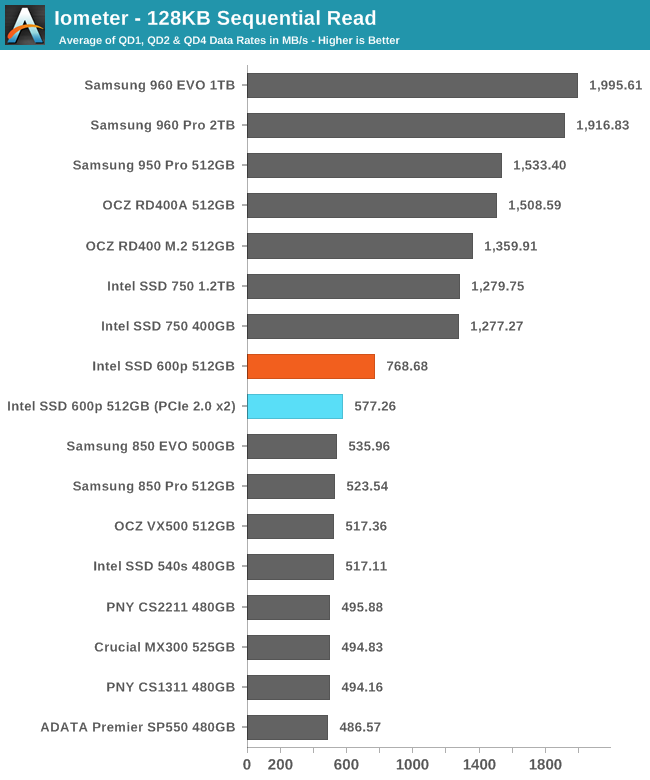
Even when limited to PCIe 2.0 x2 the 600p has slightly higher sequential read speed than SATA drives can manage, but when given more PCIe bandwidth the 600p doesn't catch up to the more expensive NVMe drives.
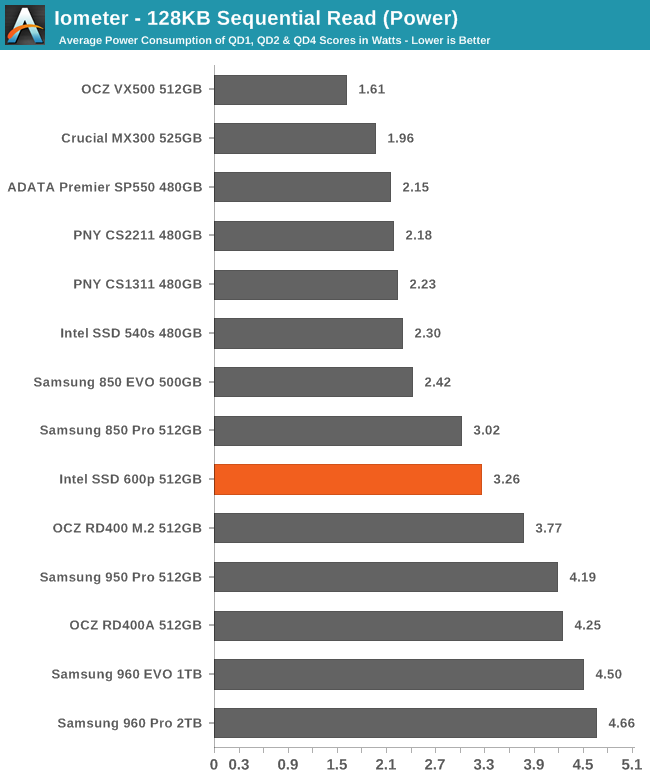
The 600p actually manages to surpass the power efficiency of several SATA SSDs, but it can't compete with the other NVMe drives that deliver twice the data rate.
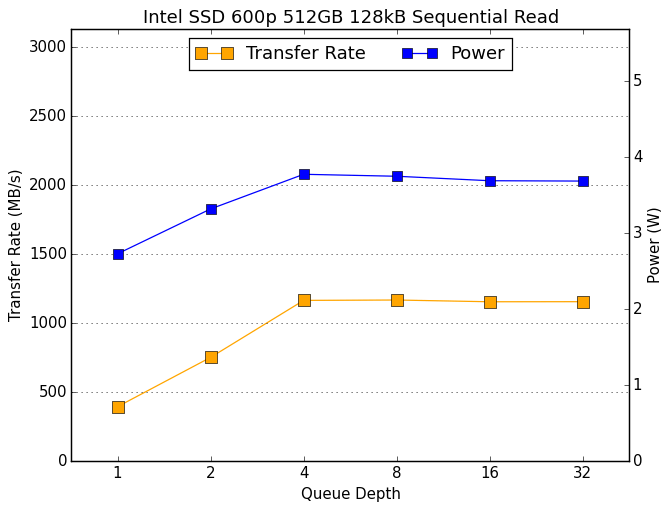 |
|||||||||
The 600p starts at just under 400MB/s hits its read speed limit at QD4 with around 1150MB/s. The other PCIe SSDs perform at least that well at QD1 and go up from there.
Sequential Write Performance
The sequential write test writes 128kB blocks and tests queue depths ranging from 1 to 32. The queue depth is doubled every three minutes, for a total test duration of 18 minutes. The test spans the entire drive, and the drive is filled before the test begins. The primary score we report is an average of performances at queue depths 1, 2 and 4, as client usage typically consists mostly of low queue depth operations.
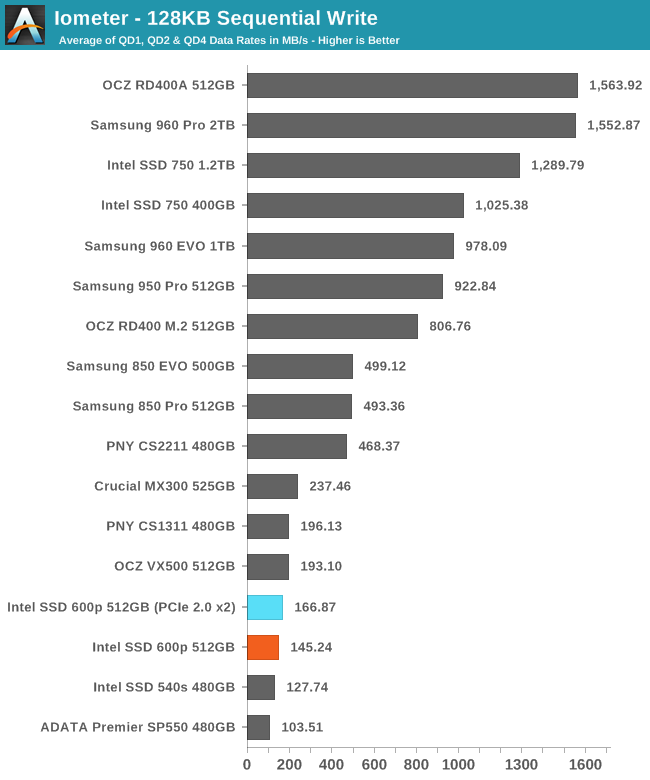
It is a surprise to see the Intel 600p performing better in the motherboard's M.2 slot than in the PCIe 3.0 adapter, but in both cases the sustained write speeds are so slow that the interface is not a limitation.
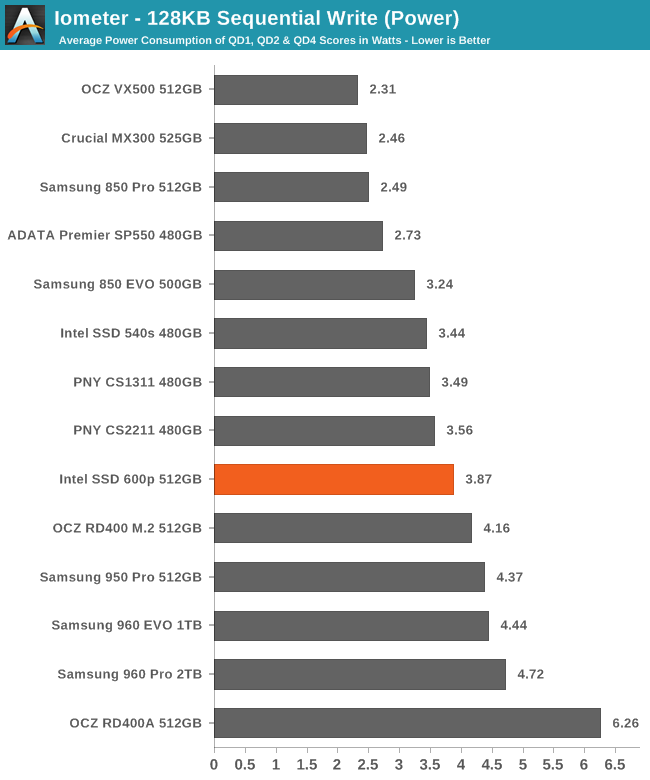
The power consumption of the 600p when it's in the PCIe 3.0 adapter is high enough that temperature may be a factor in this test, and the 600p may have performed better in the motherboard's M.2 slot simply due to better positioning and orientation in the case.
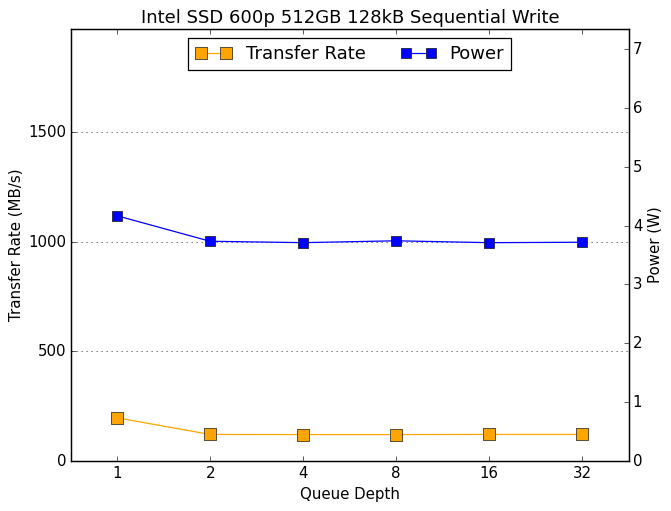 |
|||||||||
It is a familiar pattern for PCIe SSDs to see the highest write speeds at the beginning of the test, and a completely flat graph thereafter as thermal limits kick in. We're just used to seeing the performance curve near the top of the graph instead of at the bottom.
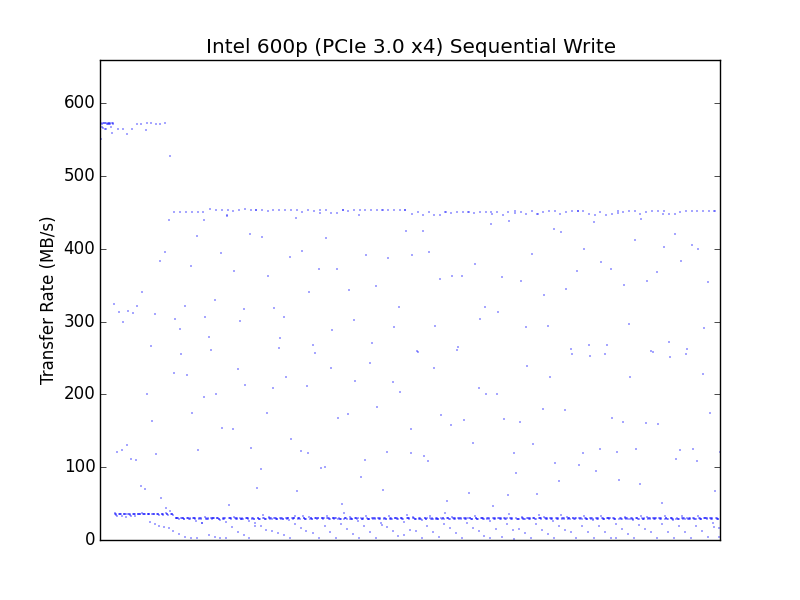 |
|||||||||
| PCIe 3.0 x4 adapter | motherboard M.2 PCIe 2.0 x2 | ||||||||
A comparison of the second by second performance during the sequential write test shows that the 600p reaches a steady state with the same kind of inconsistency we saw for random writes, and in the PCIe 3.0 adapter the performance is reduced across the board and the worst drops in performance are much closer to zero.










63 Comments
View All Comments
Billy Tallis - Thursday, November 24, 2016 - link
They're in Bench now.Flying Aardvark - Friday, November 25, 2016 - link
I have the 1TB 600P and love it. I bought it knowing full well it wasn't a benchmark king. Don't care, low QD performance has hardly improved for quite some time. But at the price, for a 5-year warranty with 0.3% failure rate per year was a no brainer over the 960 EVO for me.I can't get it to slow down or stutter in my case and if you can, you should probably step all the way up to the Intel 750, heatsink intact and all.
crazyowl - Sunday, November 27, 2016 - link
I'm not sure now to formulate this correctly so as not to hurt the reputation of the product, but there's been a report of a 600p burning a motherboard's traces when installed via a DeLonghi adapter card. Anandtech, what could you comment on that issue? Came across it in a review for the 600p at a respectable decent online shop.crazyowl - Sunday, November 27, 2016 - link
Sorry, it was DeLock, not DeLonghi. The latter seems to be a houseware brand.Billy Tallis - Sunday, November 27, 2016 - link
Our testing showed the 600p to be relatively power hungry by the standards of M.2 PCIe SSDs, but it most certainly wasn't drawing enough current to be a danger to any equipment that is capable of safely powering other M.2 PCIe SSDs. Whatever you read about was likely the result of either a manufacturing defect in the board that was supplying power to the M.2 drive, or the result of improper installation leading to a short circuit. I've killed a motherboard through the latter means, but it was only due to the modifications I've made to facilitate measuring PCIe card power consumption.Xajel - Monday, November 28, 2016 - link
I would love to have an NVMe SSD, sadly my system is old (ASUS P8Z77 ) so, it's not able to boot from NVMe.. although nothing is wrong with the chipset it can do it, but ASUS never released any BIOS update, there's some unofficial mod's which can enable this but there's no guarantee it will work or it will brick.el-loc0 - Monday, November 28, 2016 - link
@Anandtec: what equipment do you use to measure power consumption?Billy Tallis - Tuesday, November 29, 2016 - link
For PCIe SSDs, I use a riser card from Adex Electronics with current sense resistors on the 3.3V and 12V supply lines. For SATA SSDs, I use a multimeter spliced into the power cable to measure current directly.el-loc0 - Tuesday, November 29, 2016 - link
Thanks for quick reply, Billy. Do PCIe SSD Draw Power from both lines, 3.3 V and 12 V? Do you use a current clamp or how do you measure on the riser card? Which multimeter do you use?SanX - Thursday, December 1, 2016 - link
Did Intel pay for this BS review?